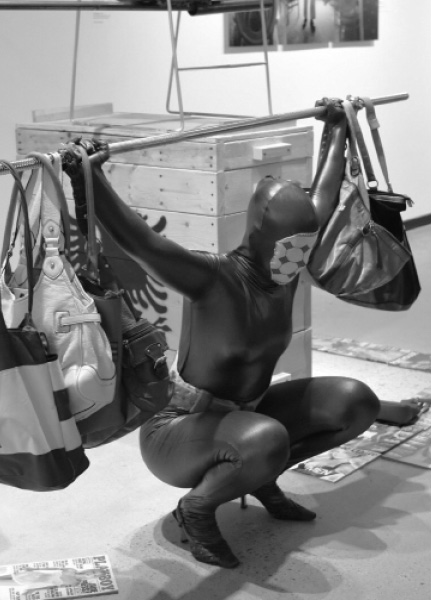
THE WEIGHT: PLAYBOYS AND VOGUE
first performed on October 11, 2017
Museum of Art, University of New Hampshire, Durham, NH
performed once in 2017
KLEDIA SPIRO
Boston, MA
854400457i854400457n854400457f854400457o854400457@854400457k854400457l854400457e854400457d854400457i854400457a854400457s854400457p854400457i854400457r854400457o854400457.854400457c854400457o854400457m
klediaspiro.com
THE WEIGHT: PLAYBOYS AND VOGUE
KLEDIA SPIRO
“The Weight: Playboys and Vogue” was a participatory performance at the Museum of Art, University of New Hampshire. The performance was in conjunction with my installation for the Made Masculine exhibition. “The Weight: Playboys and Vogue” was a challenge to classical male stereotypes. By taking what is canonically viewed as a male-dominated sport, weightlifting was used to reform assumptions about the power and strength of the female form while simultaneously challenging what it means to be masculine. By performing on a runway composed of alluring magazines, the likes of Vogue and Playboy, tension is drawn between the societal standards for both men and women. With this layout, masculinity may be referenced by both the magazines, composed of erotic images which may beguile men, and the act of weightlifting, which requires a particular physical prowess. Femininity, on the other hand, is depicted solely through the magazines, where women are modeled and posed as if they are delicate dolls in an attempt to personify beauty itself.
I enter the white-wall gallery space appearing in a full-body, bronze suit and high heels, removing myself from the piece as a means of referencing the female form as a whole. After a brief warm up, I begin to stuff magazines in purses and encourage the audience to do the same, allowing viewers to increase the amount of weight lifted by placing the magazine-filled purses on my barbell while traversing the space. As the weight increases, the strain I exert is exhibited solely by the sound of my breathing, which exasperates with every addition. Through these methods, I not only exhibit the strength and persistence of the female form, contrasted with its delicacy in the magazines, but also depict the literal and figurative pressures placed on the male form by society, as I assume his conventional role as weightlifter. In this way, I not only abolish the gender stereotypes set by societal standards but also question what it means to be made masculine.